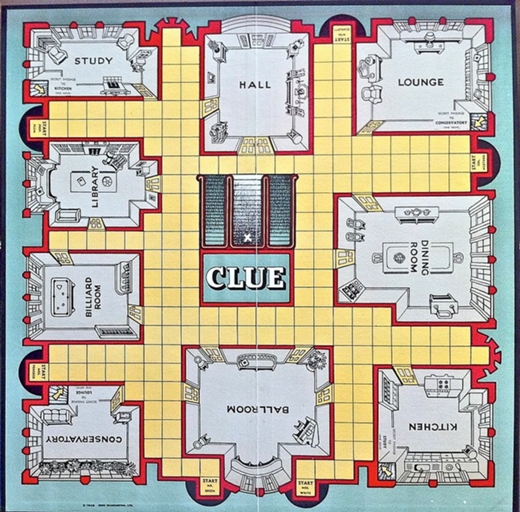Holed up in his home in Birmingham, England during air raids on the city during World War II, Anthony E. Pratt, an English musician and factory worker, recalled the murder mystery games played by some of his clients at private music gigs as well as the detective fiction popular at the time, most notably Agatha Christie. In 1944, Pratt applied for a patent of his invention of a murder/mystery-themed game, originally named Murder! Shortly thereafter, Pratt and his wife, Elva Pratt, who had helped design the game, presented it to Waddingtons' executive Norman Watson, who immediately purchased it and provided its trademark name of Cluedo (a play on "clue" and Ludo, ludo being Latin for "I play").

Although the patent was granted in 1947, postwar shortages postponed the game's official United Kingdom launch until 1949. It was simultaneously licensed to Parker Brothers in the United States for publication, where it was renamed Clue.
There were several differences between the original game concept and the one initially published in 1949. In particular, Pratt's original design calls for 10 characters, one of whom was to be designated the victim by random drawing prior to the start of the game. These 10 included the eliminated Mr. Brown, Mr. Gold, Miss Grey, and Mrs. Silver. The characters of Nurse White and Colonel Yellow were renamed Mrs. White and Colonel Mustard for the actual release. The game allowed for play of up to eight remaining characters, providing for nine suspects in total. Originally there were 11 rooms, including the eliminated gun room and cellar. In addition, there were nine weapons, including the unused bomb, syringe, shillelagh (walking stick/cudgel), fireplace poker, and the later used axe and poison. Some of these unused weapons and characters appeared later in spin-off versions of the game.
Some gameplay aspects were different as well. Notably, the remaining playing cards were distributed into the rooms to be retrieved, rather than dealt directly to the players. Players also had to land on another player in order to make suggestions about that player's character through the use of special countertokens, and once exhausted, a player could no longer make suggestions. There were other minor differences, all of which were later updated by the game's initial release and remain essentially unchanged in the standard Classic Detective Game editions of the game.